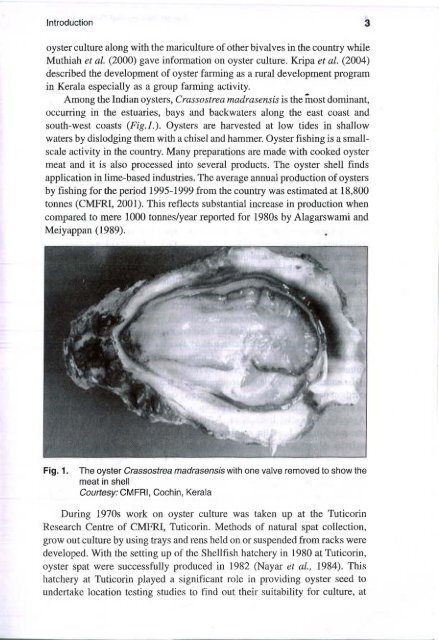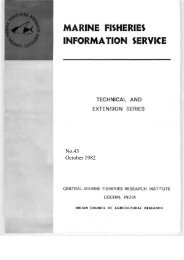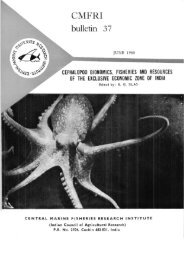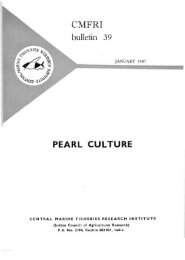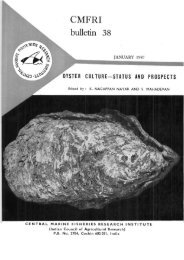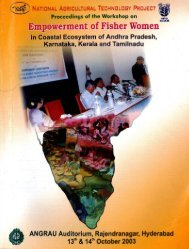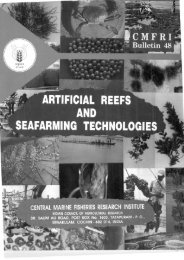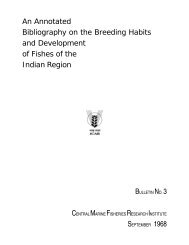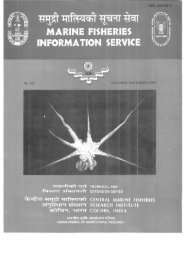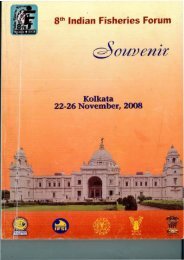Introduction 3oyster culture along with the mariculture of other bivalves in the country whileMuthiah et ai. (2000) gave information on oyster culture. Kripa et al. (2004)described the development of oyster farming as a rural development programin Kerala especially as a group farming activity.Among the Indian oysters, Crassostrea madrasensis is the most dominant,occurring in the estuaries, bays and backwaters along the east coast andsouth-west coasts (Fig.I.). Oysters are harvested at low tides in shallowwaters by dislodging them with a chisel and hammer. Oyster fishing is a smallscaleactivity in the country. Many preparations are made with cooked oystermeat and it is also processed into several products. The oyster shell findsapplication in lime-based industries. The average annual production of oystersby fishing for the period 1995-1999 from the country was estimated at 18,800tonnes (CMFRI, 2001). This reflects substantial increase in production whencompared to mere 1000 tonnes/year reported for 1980s by Alagarswami andMeiyappan (1989).Fig. 1.The oyster Crassostrea madrasensis with one valve removed to show themeat in shellCourtesy: CMFRI, Cochin, KeralaDuring 1970s work on oyster culture was taken up at the TuticorinResearch Centre of CMFRI, Tuticorin. Methods of natural spat collection,grow out culture by using trays and rens held on or suspended from racks weredeveloped. With the setting up of the Shellfish hatchery in 1980 at Tuticorin,oyster spat were successfully produced in 1982 (Nayar et ai., 1984). Thishatchery at Tuticorin played a significant role in providing oyster seed toundertake location testing studies to find out their suitability for culture, at
4 Oyster Biology and Culture in Indiaseveral places along the Indian coast. The very first attempt in 1993 to test thesuitability of the Ashtamudi Lake in Kerala for oyster culture proved successfuLIn 1994, the CMFRI has set up a rack and ren oyster culture demonstrationfarm in the Ashtamudi Lake. This water body proved to be a very good sitefor oyster seed collection. The first commercial oyster farm was set up in 1996by an enterprising farmer in the Ashtamudi Lake, close to the demonstrationfarm of CMFRI, followed by several villagers venturing into oyster culture inthe estuaries of Kerala. Beginning in 1980s at Tuticorin and since 1995 atAshtamudi, the CMFRI is conducting training programmes covering all aspectsof oyster culture to farmers and others, lending technology support and islinking the farmers with developmental agencies for finance and marketing.The rack and ren method of farming is adopted by the farmers. The annualproduction of farmed oysters CC.madrasensis) in India is estimated to bebetween 750-800 tonnes.In India, coastal aquaculture is at present mainly centered around shrimps,largely due to their high price, demand in the export trade and the technologicaladvancements made in breeding, seed production and field culture. However,over the past decade, frequent disease outbreaks and negative environmentalimpact of their culture in coastal areas have greatly hampered the acceleratedexpansion and extension of this sector. In this context, entrepreneurs andfarmers are attempting to diversify the farmed species, and oysters are amongtlte most prefe~red . pede , in vjew of their.bi logical haract ri t1 adaptivcapacity to varying environmental conditions, growing demand in exportmarket and enlarging acceptance by the domestic consumers. In this scenario,the foremost requirement of developing oyster culture on a scientific andsustained basis is the availability of information on different aspects of itsculture and the related paradigm. This book on oyster biology and culture inIndia endeavours to meet this requirement. It is mainly written to cater to theneeds of university teachers, researchers and students in India. It is also usefulto a wide spectrum of personnel drawn from <strong>Fisheries</strong> / Rural DevelopmentAgencies, Financial Institutions, NGOs and entrepreneurs. In the chapterspresented in this book the emphasis is chiefly on the status of oyster culturein India. Also the progress made in oyster culture in the major oyster producingcountries of the world is briefly reviewed. The recent technological advancesmade in other countries in the hatchery production of seed and grow outculture have been dealt with. In the light of the developments in oyster culturein other countries, the gaps in knowledge, future research needs, constraintsfaced by farmers and the steps to be taken for the development of oysterresources and culture on a sustainable basis in the Indian context are highlighted.The production of figures in tonnes by weight given in this book are inmetric tonnes.QUESTION1. Write briefly on the development of oyster culture in India•


